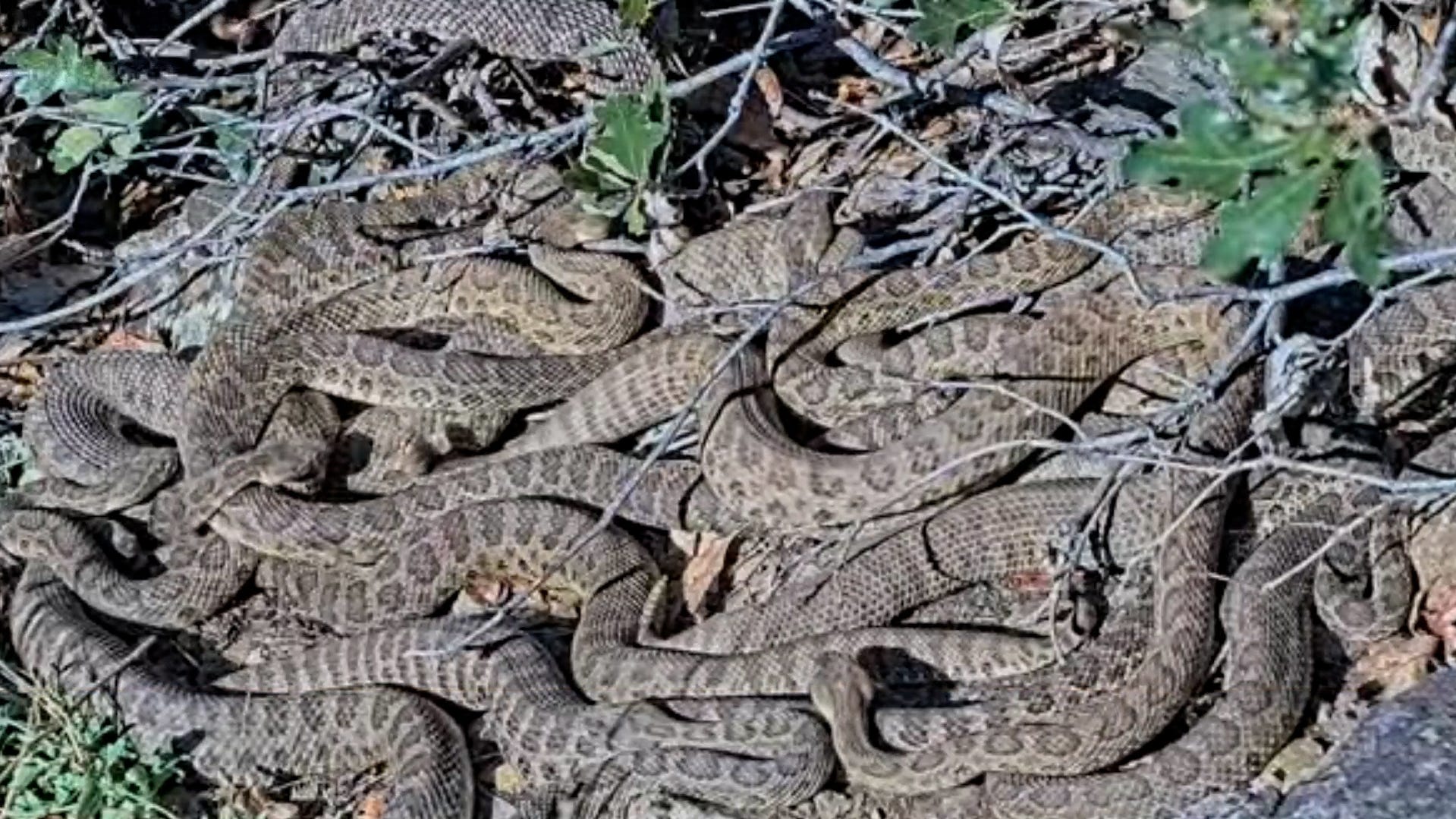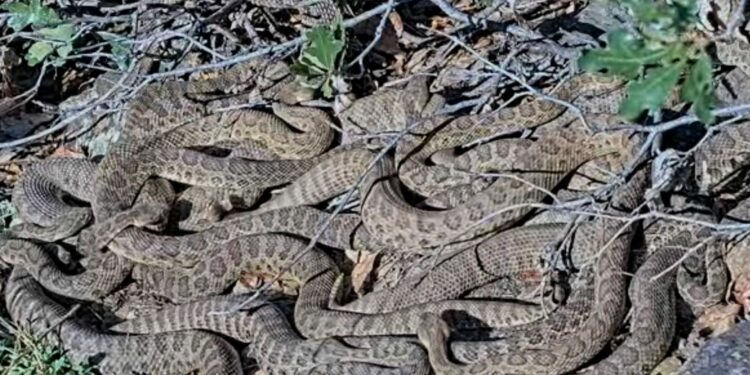
Project Rattlecam’s livestream goes inside rattlesnake ‘mega-den’
Project Rattlecam shows viewers an inside look at snake life, including a massive Colorado rattlesnake “mega-den.”
Arizona’s diverse wildlife includes some of the most painful and poisonous creatures found in the desert. From the excruciating sting of the tarantula hawk wasp to the potentially life-threatening bite of the Western Diamondback Rattlesnake, the state is home to a variety of insects, arachnids, and reptiles capable of delivering intense pain or potent venom.
The Arizona bark scorpion, with its sharp, electric sting, and the aggressive Africanized honey bee, known for its painful stings and swarming behavior, further highlight the potential risks. Meanwhile, the giant desert centipede and desert hairy scorpion, though less deadly, still pose significant discomfort.
Here is everything you need to know about the 10 meanest bugs in Arizona.
Arizona bark scorpion
The Arizona bark scorpion delivers an intensely painful sting, often described as sharp and electric, causing numbness, tingling and muscle spasms. The venom, while rarely fatal, can cause severe symptoms such as difficulty breathing, particularly in children and older peopole. Immediate medical attention is recommended, especially if symptoms are severe.
While waiting for help, applying ice can help reduce pain and over-the-counter pain relievers may offer some relief. Stay calm and immobilize the affected area to slow the spread of venom.
Gila monster
When a Gila monster bites, it chews venom into the wound, causing intense burning, swelling and a feeling of pressure. The venom is potent and not usually deadly, but it can lead to significant discomfort, dizziness, nausea and a drop in blood pressure. Seek medical attention to manage pain and monitor for complications.
While waiting for help, keep the bite area immobilized and elevated. Avoid using a tourniquet or trying to suck out the venom.
Tarantula hawk wasp
The tarantula hawk wasp’s sting is often described as a searing electric shock that can incapacitate its victim temporarily. While the venom is highly toxic to insects and paralyzes them, it is not lethal to humans. The pain, however, can last for several hours, often accompanied by redness and swelling.
Treatment generally focuses on pain relief; applying ice can help reduce swelling and discomfort, and anti-itch creams can alleviate symptoms. If you experience difficulty breathing, swelling beyond the sting site or other severe symptoms, seek medical attention.
Africanized honey bee
The sting of an Africanized honey bee, also known as a killer bee, is similar to that of a typical honey bee but more intense. And because of the bees’ aggressive swarming behavior, you might be stung multiple times.
The venom causes a sharp, burning pain and redness, swelling and itching at the sting site. While the venom of one bee is not typically deadly to humans, multiple stings or an allergic reaction can be dangerous. Remove the stinger promptly, apply ice to reduce pain and swelling, and use anti-itch creams to relieve itching.
Symptoms such as difficulty breathing, rapid heartbeat and swelling of the face or throat indicate the need for medical care.
Western diamondback rattlesnake
One of the most dangerous animals you can get bitten by in Arizona is the Western diamondback rattlesnake. Symptoms include intense throbbing, swelling and tissue damage. The venom is potent and can cause severe pain, necrosis (tissue death), nausea, dizziness and difficulty breathing.
A Western diamondback rattlesnake bite is a serious emergency requiring immediate attention. Antivenom and other treatments are necessary to prevent severe complications.
While waiting for help, keep the bite area immobilized and below heart level to slow the spread of venom. Avoid applying ice or using a tourniquet, as these can worsen the situation.
Black widow spider
A black widow bite can cause a sharp, burning sensation that can escalate to severe muscle cramps and rigidity. The venom is neurotoxic and can lead to nausea, sweating and severe abdominal pain, though it is rarely fatal.
Applying ice to the bite site can help reduce pain and swelling, and over-the-counter pain relievers can provide some relief. Seek medical care to manage the effects of the venom and prevent complications.
Desert hairy scorpion
According to Blue Sky Pest Control, a pest control service in metro Phoenix, a sting from a desert hairy scorpion causes moderate pain, similar to that of a bee sting, with localized swelling and redness. The venom is not highly toxic to humans and is less severe compared to other scorpions.
Applying ice to the sting site can reduce pain and swelling, and over-the-counter pain relievers may help.
Blister beetle
Blister beetles do not bite or sting; instead, they can release a toxin called cantharidin if crushed against the skin. This toxin isn’t deadly but does cause painful blisters.
Wash the affected area thoroughly with soap and water to remove any remaining toxin. Anti-itch creams or ointments may soothe the irritation. If large blisters or severe reactions develop, or if the toxin is ingested, seek medical attention.
Giant desert centipede
According to Orkin, the giant desert centipede’s bite can cause sharp, burning pain and significant swelling. Its venom, while potent to its prey, is not usually deadly to humans but can lead to severe discomfort and localized inflammation. Self-care remedies such as applying ice and using pain relievers can help.
Red imported fire ant
According to Orkin, the sting of a red imported fire ant starts with a burning sensation that intensifies and can lead to the formation of small, pus-filled blisters. The venom contains alkaloids that cause intense pain and itching.
While the venom is not typically deadly, multiple stings or an allergic reaction can be dangerous.
Remove any stingers promptly and wash the area with soap and water. Seek immediate medical attention if you experience severe symptoms such as difficulty breathing or widespread swelling, as these may indicate a serious allergic reaction.
Got a story you want to share? Reach out at [email protected]. Follow @tiffsario on Instagram.
Support local journalism and subscribe to azcentral.com.
Source link : http://www.bing.com/news/apiclick.aspx?ref=FexRss&aid=&tid=66f400603507438883d96c53ddaf8d3f&url=https%3A%2F%2Fwww.azcentral.com%2Fstory%2Fentertainment%2Flife%2F2024%2F09%2F25%2Fmost-painful-insect-reptile-bites-arizona%2F74725163007%2F&c=16423049582560602882&mkt=en-us
Author :
Publish date : 2024-09-25 01:00:00
Copyright for syndicated content belongs to the linked Source.



